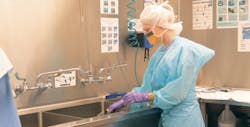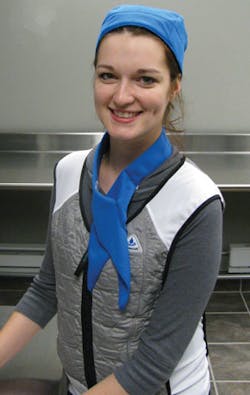When it comes to protecting sterile processing professionals on the job, certain activities and environments require them to wear very specific personal protective equipment (PPE). Healthcare Purchasing News invited Healthmark Industries Vice President Ralph Basile to explain what CS/SPD employees must wear and why, what their biggest concerns are, and what the standards are for CS PPE (and what they’re not).
HPN: When it comes to PPE, please describe the unique needs of CS/SPD staff — how do they differ from those of clinical staff?
Ralph Basile: The needs in reprocessing departments are significantly different than those in procedure areas. There are two distinct areas in SPD PPE:
In the decontamination or “dirty side” where clinically contaminated medical devices are delivered and cleaning commences, workers need maximum protection. They are typically in greater danger than even staff in procedure areas (of course there are exceptions). This is because not only are they handling devices soiled with contaminated patient-derived soils but they are doing so in an environment and a way that puts them at particular risk for:
1. Aerosolization as they are rinsing (with shower/spray guns), scrubbing (with brushes or other tools), and immersing in baths of water and cleaning solution
2. Handling these devices to clean not just the handles (or proximal ends) but also the “working” part of the devices, including the sharp points, edges, etc.
For this reason, workers need to wear gowns, face masks, shoe coverings, etc., that are impervious to liquids, blood and other organics, and even chemicals. They also need gloves that are defined as “utility gloves” — extra thick and leak-proof. Gloves need to extend above impervious gowns and provide a watertight seal, so that liquid does not soak and enter between the gown and glove. Puncture- and cut- resistance is a plus, but does represent a challenge to the realities of handling devices for cleaning. Face shields that are not only splash- resistant but provide complete face and neck protection is also required.
What are the standards and guidelines specific to sterile processing PPE?
While everyone recognizes the challenges associated with PPE in decontam, currently there are very loose guidelines for appropriate attire. OSHA, AAMI, ASTM, AORN, IAHCSMM, etc., use terms like “impervious,” “leak-proof,” “splash-resistant.” But if you look for specific guidance based upon well-defined standards of performance, you will currently not find that in any of the guidance documents from these groups.
AAMI PB70, and a number of ASTM Standard Test Methods do provide guidance and testing procedures for PPE used in clinical settings, but not in decontam. That is changing. The AAMI Protective Barriers Committee is taking up this issue as it works to revise and update PB70 (the most widely used/referenced guidance document for healthcare PPE). Concurrently, ASTM Committee F23 is also taking up issues related to testing decontamination attire to be sure PPE claiming to comply with AAMI PB70 guidelines do so.
Having said this, it is important to point out that the soon to be published version of AAMI ST79 does significantly move the ball down the court.Not only does it provide further guidance on decontam PPE, but it also has a new annex discussing worker comfort and methods for managing core body temperature.
What about the “clean side” of sterile processing — what should staff be wearing?
When it comes to PPE on the “clean side,” often referred to as prep and pack, the issues are not quite as cloudy. This is because staff is presumably handling devices that have been thoroughly cleaned and are safe to handle with bare hands. Here the standards are less about protecting the worker and more about preventing the contamination of the device as they are prepared for further processing (e.g., sterilization, HLD).
In 2014, the AORN Guidance document on PPE mandated that staff in the prep and pack area wear attire that completely covers arms. Other sources of contamination for workers (e.g.,facial) were also mandated.
What are some of the issues or complaints among SPD professionals regarding PPE?
The challenge with wearing high-level of protection is that it compromises tactile feel and dexterity. Further, the impervious clothing, by nature, typically does not “breath” — or has limitied heat and sweat evaporation. The result is an employee expected to do very intricate and complicated steps, while suited up in something approaching a space suit but without the body temperature management tools an astronaut can count on. Cooling products are available in the market to help manage body heat. These tools are relatively inexpensive and easy to use.
In AAMI TIR55, published a couple years back, these issues were addressed head on as important human factors in the design of medical devices for reprocessing. Those same themes are reflected in AAMI TIR12 (currently undergoing revision), AAMI ST79 and AAMI ST91, to name some other significant guidance documents. Similarly, the 2015 FDA Reprocessing guidance document discusses human factors related to device reprocessing and states that these need to be considered as part of validation of reprocessing instructions. Soon to be published, AAMI/ISO17664 provides similar guidance.
Management of body temperature is also a major issue with PPE worn in decontam. The new AAMI ST79 will address these issues specifically in a new Annex. Workers that are uncomfortable and have additional challenges with dexterity cannot be expected to perform at maximum ability.
There is still some staff resistance to the 2014 AORN Guidance document on PPE and wearing clothing that limits contamination of cleaned devices. Some employees find wearing long-sleeved scrub jackets uncomfortable. Facial-hair covers face similar resistance. But as with any new guideline, compliance is increasing and staff are adjusting. Tools to stay cool, again, are important accessories.
Finally, head covers, long mandated, are a challenge to launder and return by an institutional laundry service. Yet, workers like to wear head covers to express their own persona. Wearing home-laundered clothing in the reprocessing area is counter to guidelines and good practice. But compliance remains a challenge for many facilities.
How does the Healthmark PPE line address those concerns?
Healthmark has long supplied PPE products. An area that we pioneered just a couple years ago is our Cool Aids. This helps staff manage their body temperature, with solutions that are inexpensive and easy to use. Our evaporative cooling products are quickly “activated” by immersing in cool water, wrung out and then worn around the neck, or head. Our Cool Aid vests come in both reusable and single-use styles. These vests are designed to hold up to four of our phase change cooling packs (the cooling packs are reusable) and provide active cooling under outer attire, including PPE.
When it comes to covering arms in the prep and pack area, we recently introduced a line of “sport sleeves” that are designed to go from the wrist area all the way up the arm below the sleeve. These are made of a breathable material that wicks away moisture. They are available in three colors.
Do you have anything in the pipeline?
We are always working on new items to help our SPD customers, whom we value so much. For instance, we recently introduced an adjustable back brace to provide further protection and comfort for staff.
Stay tuned to the pages of HPN and we are sure to be announcing even more innovative products soon!
About the Author

Valerie J. Dimond
Managing Editor
Valerie J. Dimond was previously Managing Editor of Healthcare Purchasing News.


